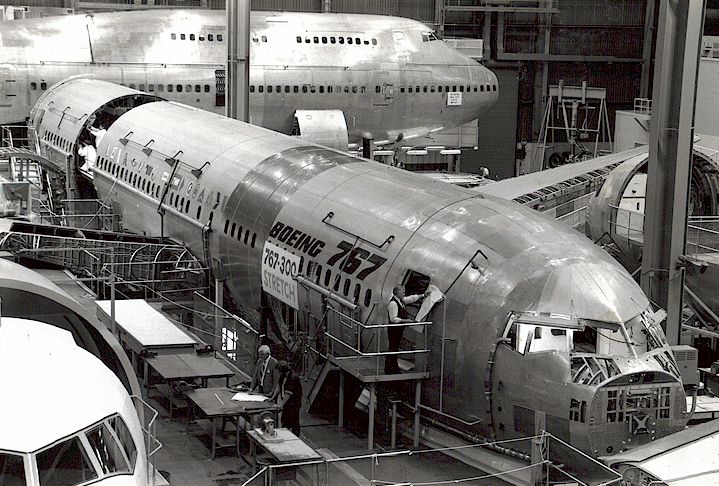



767 cockpit

Take off
The Cheapest Aircraft Store on the Web
|
DevelopmentThe Boeing 767, a widebody jet, was introduced at around the same time as the 757, its narrowbody sister, in the 1981-1982. Prior to production, it was referred to as the 7X7.[3] With the 707 aging, Boeing decided to offer a mid-size plane to fit in between the 727/737/757 and the 747. The aircraft has a fuselage width of 15 ft 6 in (472.44 cm) that splits the difference between the aircraft in half. The 767 was approved for U.S. CAT IIIb operation in March 1984. This revision permitted operations with minimums as low as RVR 300 (Runway Visual Range 300 feet). It was the first aircraft certificated for CAT IIIb by the U.S.[4] The 767 offers a twin aisle configuration of 2+3+2 in economy with the most common business configuration of 2+2+2. It is possible in some charter configurations to squeeze an extra seat for a 2+4+2 configuration, however the seats are very narrow and this is not common. The 767 has a seat-to-aisle ratio in economy class of 3.5 seats per aisle, making for quicker food service and quicker exit of the plane than many other jetliners, which typically have between four and six seats per aisle in economy class. The flight decks of the Boeing 757 and 767 are very similar and as a result, after a short conversion course, pilots rated in the 757 are also qualified to fly the 767 and vice versa. Newer 767-200s and 767-300s, as well as all 767-400ERs, feature a 777-style cabin interior, also known as the "Boeing Signature Interior". The 767-400ER also features larger windows exactly like those found on the 777. All new 767s currently built feature the Signature Interior, and it is also available as a retrofit for older 767s. In the late 1980s, Boeing proposed a stretched version of the 767, then a partial double deck version with a parts of a 757 fuselage built over the aft (rear) fuselage.[5][6] These concepts were not accepted and Boeing shifted to an all new airliner that would become the 777.[7] Boeing would later develop a stretched 767 version in the form of the 767-400ER in the late 1990s. In addition to the Boeing Signature Interior retrofit option, a simpler mod known as the "Boeing 767 Enhanced Interior" is available. This retrofit borrows styling elements from the Boeing Signature Interior; however, the outer section overhead bins are traditional-style shelf bins rather than the 777-style pivot bins. The 767 sold very well in from late 1980s to the late 1990s, with a decrease during the recession in the early 1990s. After strong sales in 1997, sales have declined significantly, due to the economic recession of the early 2000s, increased competition from Airbus, and the recent emergence of a direct replacement program, the Boeing 787. Boeing has kept the line open due to KC-767 tanker program, which use the 767 airframe. In early 2007, United Parcel Service and DHL have prolonged the 767's production with orders for 767-300 freighters of 27 and 6, respectively.[1][2] The renewed interest in the 767-300 freighter has Boeing considering enhanced versions of the 767-200 and 767-300 freighter, with increased gross weights, 767-400ER wing technology, and 777-200 avionics.[3] Boeing sees the advanced 767-200F and 767-300F as complementing the 777F, and allowing Boeing to compete more effectively against the A330-200F, which is larger than the proposed 767-200F and 767-300F, but smaller than the 777F. As of July 2007, the Boeing 767 has 1011 orders, with 953 of those delivered. Delta Air Lines is currently the world's largest 767 operator, with approximately 102 planes, including the 767-300, 767-300ER, and 767-400ER. Hartsfield-Jackson Atlanta International Airport, their hub, has the highest number of Boeing 767 operations in the world.
|
Offered for free by HLebooks.com